The Whale Shark is the largest fish in the entire Ocean! The “Whale” part in its name describes his length which is comparable to Whales. They are also “filter feeders” like Whales. Basically, they swim through the water and use their immense gills as a filter, capturing plankton and vegetation as it swims.
The Whale Shark is also called the Rhinocdon typus and it is an enormous shark. It’s actually the biggest shark and fish in the world! Would you believe an average adult is the length of a school bus?! They typically grow to about 10-12 m (33-40 ft), but may reach 18 m (60 ft) in length. They can weigh up to 15 tons. Of course no one really knows for sure, because there isn’t much known about the size of Whale Sharks at maturity. People are truly fascinated by these gentle giants, yet surprisingly little is known about their life history, compared to other large sharks.
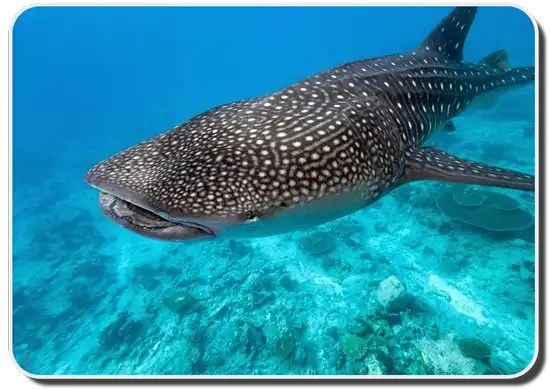
It’s hard to imagine a fish that big, but I can tell you first hand that even a young one is humongous! I went scuba diving in Zanzibar, in East Africa, and our dive master pointed through the water ahead of us excitedly. I saw a beautiful school of silvery fish swim by. Then my eyes focused just behind the fishes, and I realized they were covering a much bigger creature! It was grey with pale spots, and stretched longer than our whole group of divers. Back in the boat, he explained we had seen “just” a baby Whale Shark. Imagine what it would be like to swim beside an adult!
Since they are filter feeders, they naturally have very large mouths. In fact, the mouth of this beast can reach widths of 1 to 1.5 meters (3 to 5 feet).
In comparison, they have very small teeth but make up for that in quantity. An adult can have up to 300 rows of teeth and include about 3,000 teeth in its entire mouth. Imagine the dental bill!
Just how big do they get? The biggest one ever measured had a length of about 13 meters (42 feet) and weighed more than 22 metric tons (more than 48,500 pounds)!! But even still, experts claim that there must be bigger ones out there. This species can live 100 years or longer. That gives them a lot of time to grow!
This shark is a slow and leisurely swimmer with an average speed of just 5 kilometers per hour (3mph). Because of their gentleness and harmlessness, they are often visited by shark divers.
Whale Sharks are filter-feeders that travel the world’s warm oceans. They are usually solo, but in areas where food is concentrated, Whale Sharks gather in large numbers.
This is a slow and leisurely swimmer with an average speed of just 5 kilometers per hour (3mph). Because of their gentleness, they are visited often by divers.
The skin has pale yellow markings of stripes and dots on a dark gray background. Each individual has a unique pattern that allows identification, just like human fingerprints. This is an incredible tool for research and conservation. For example, the World Wildlife Fund (WWF) has identified 458 different Whale Sharks in the Philippines using photos of their skin patterns. Young Whale Sharks appear to have a tough time out there. The mother leaves her young after birth, and less than 1 in 10 are thought to survive to adulthood. However those that make it may have a lifespan of up 100 or 150 years! Again, no one really knows for sure. Some researchers think the Whale Shark’s closest relative is the relatively puny Zebra Shark.
Habitat
These sharks love temperate and warm waters. Therefore, it generally tends to stay in waters along the equator.
Whale Sharks are nomadic. Genetic studies (of Whale Shark history and evolution) have shown that they swim all around the globe through temperate and tropical waters (other than the Mediterranean), with no real barriers to movement. They usually stay in deep waters (about 800 m / 2,600 ft), but sometimes move closer to coastal areas, especially near coral reefs.
Over the last 15 years, many studies have placed satellite tags on Whale Sharks to track their movements. Results confirm that most tagged sharks are very mobile but they swim slowly. They stay within 125 miles of shore, and make regular deep dives (up to 240 m / 790 ft), sometimes coming to the surface to feed. One shark traveled 13,000 km over a three-year period!
Each spring they migrate to the continental shelves around Australia, possibly to feed on the plankton (tiny marine animals and plants) that occur there in great numbers. In fact, marine scientists think the location of Whale Sharks can be used to measure the presence of plankton and the overall health of our oceans.
Location
Whale Shark Habitat Map
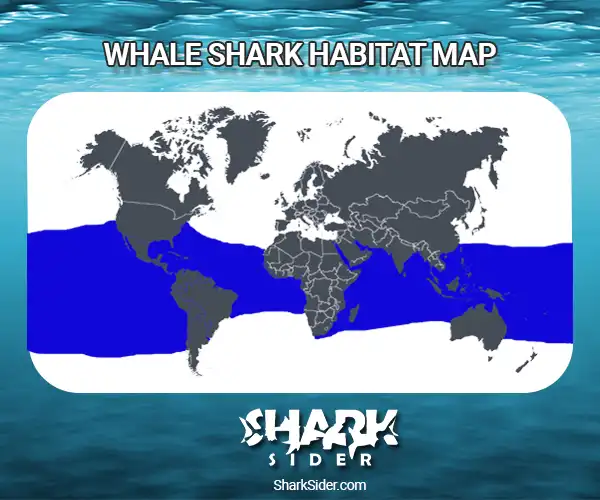 Whale Sharks tend to enjoy temperate to warm waters. Because of this, they are generally found in the waters along the Equator. The fish is primarily pelagic, meaning that they live in the open sea, but not in the greater depths of the ocean. With this in mind, Whale Shark habitat is usually found in the waters around South Africa, Central America, and South America. Although they are typically seen offshore, the Whale Shark has been seen close to land, entering various lagoons and coral searching for food.
Whale Sharks tend to enjoy temperate to warm waters. Because of this, they are generally found in the waters along the Equator. The fish is primarily pelagic, meaning that they live in the open sea, but not in the greater depths of the ocean. With this in mind, Whale Shark habitat is usually found in the waters around South Africa, Central America, and South America. Although they are typically seen offshore, the Whale Shark has been seen close to land, entering various lagoons and coral searching for food.
Reproduction
Like other sharks, the reproduction process takes a lot of time. The Whale Shark’s habitat is affected by this procedure. Like great white sharks, the Whale Shark is ovoviviparous, meaning that the egg remains within the body and the females give birth to live young. There is evidence that suggests that Whale Shark pups are not all born at once. Scientists have suggested that females are able to retain sperm for one mating session, and produce a steady flow of pups over a long period of time.
Social Behavior
Whale Sharks are some of the most social of all sharks. But there is still a cloud of mystery surrounding the exact details such as social structure and dominance.
When it comes to humans, this species poses virtually no threat. Many divers sometimes even hitch a ride with one of these gentle giants! The number one injury to humans from this shark is getting hit with the huge tail fin. This shark is truly a docile creature.
Feeding Behavior
The Whale Shark is a “filter feeder”, like some Whales. The mouth is at the very front of its head (different from most sharks who have their mouth on the underside of the head). It is also gigantic, nearly five feet wide. This allows the Whale Shark to swallow a lot of plankton, using its gills as a “suction filter” while it swims. Relative to other sharks, they have very small teeth but make up for that in quantity. An adult can have up to 300 rows with about 3,000 teeth in its entire mouth! However it can’t bite or chew.
The Whale Shark Diet
The Whale Shark diet is very unique considering the creature’s sheer size and presence in the ocean. The Whale Shark is a filter feeder, one of only three known filter feeding shark species, the other two being the basking shark and the megamouth shark. It feeds on plankton, which includes copepods, krill, and fish eggs. The Whale Shark diet also consists of clouds of eggs during mass spawnings of fish and corals.
The shark has many rows of vestigial teeth, which play no role in feeding. Instead, feeding occurs in two ways. The first method is ram filtration, where the animal opens its mouth and swims forward, pushing water and food into the mouth. The second method is called active suction feeding, where the animal opens and closes its mouth, sucking in huge amounts of water which are then expelled through its gills.
In both types of consumption, the filter pads are used to separate the food from the water. These filter pads are black screen-like structures that are presumed to act as gill rakers, sifting the food from the water and making for a cleaner digestion. Food separation in Whale Sharks is possible due to cross-flow filtration. This process involves water traveling parallel to the filter pad surface, before passing to the outside of the creature. The denser food particles will then continue onward towards the back of the throat. This is a remarkable method of filtration that minimizes the likelihood of fouling the filter pad surface. Funny enough, the Whale Sharks have also been spotted coughing in the water, presumably to clear any build up of particles on the filter pad surface.
Breeding
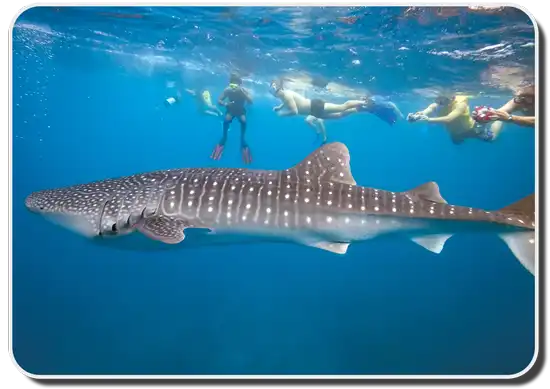 The Whale Shark’s breeding method was debated in the past. Some researchers believed they were egg-layers(“oviparous”) because egg cases were observed in the oviducts of females during autopsies. Others claimed they were live-bearers (“Viviparous“). It remained a mystery until a 1995 finding proved they give birth to live young.
The Whale Shark’s breeding method was debated in the past. Some researchers believed they were egg-layers(“oviparous”) because egg cases were observed in the oviducts of females during autopsies. Others claimed they were live-bearers (“Viviparous“). It remained a mystery until a 1995 finding proved they give birth to live young.
In fact, like many other sharks, the Whale Shark is “Viviparous” the embryos develop inside egg cases, but they hatch inside the uterus. The female caught in 1995 contained about 300 embryos, the largest litter size reported for any shark species. These baby sharks certainly don’t start out as giants. Normally, they range in size from 30 to 50 cm (11 to 20 in) at birth.
Whale Shark Weight
The Whale Shark is an extremely unique creature for a number of reasons. Firstly, the shark holds many records for its sheer size within the animal kingdom. There have been common reports that these fish can be over 46 feet long and weighing at least 66,000 pounds. As you can tell, these creatures are massive!
What Makes Whale Sharks So Big?
It seems that scientists may have figured out the reasoning behind the Whale Shark’s weight. The large, krill eating sharks appear to be negative buoyant, meaning that they sink to the bottom of the ocean in order to reach their food. Because of this, the Whale Shark conserves up to 30 percent of the energy needed to stay down in the depths of the ocean. This energy conservation allows Whale Sharks to stay warmer for longer periods of time, which in turn, directly affects the length of time they can forage for food.
There is another factor involved regarding Whale Shark weight and their overall size. Research shows that the critical organs of a Whale Shark are surrounded by huge blocks of white muscle, which appear to insulate the Whale Shark. This allows these sharks to stay warmer for longer, despite deep expeditions to the colder areas of the ocean. For Whale Sharks, the larger they get, the more heat they can store. Therefore, they can forage longer for food. Because of these biological observations, scientists believe that Whale Sharks have evolved to become bigger and bigger over time.
Other Reasons For A Whale Shark’s Weight
There may be some other reasons that contribute to a Whale Shark weight and size. First off, by being a large creature, their foraging range is increased. This enables them to travel farther in search of prey, and allows them to store greater amounts of food while traveling between patches of rich feeding zones. By being large in size, Whale Shark’s also have the ability to process huge amounts of water. A larger mouth allows for greater volumes of water to be consumed, and therefore, more plankton to be eaten. Lastly, because a Whale Shark’s weight is so great, they have relative freedom from any types of predation. Most predators are too small to mess with these creatures.
Humans and Conservation
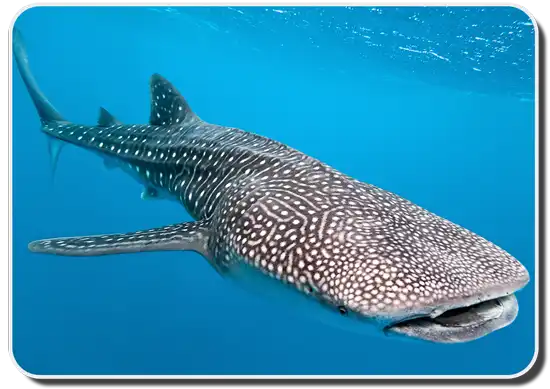 This species poses no real threat to humans. Unfortunately the reverse isn’t true. Whale Shark deaths due to human activity are caused mainly by collisions with boats and by fishing.
This species poses no real threat to humans. Unfortunately the reverse isn’t true. Whale Shark deaths due to human activity are caused mainly by collisions with boats and by fishing.
The biggest danger is the international demand for shark products: fins, liver oil (used to waterproof wooden boats), skin, and meat. Sadly the meat is often discarded. Whale Sharks are also victims of “Bycatch“, which is the accidental capture of non-target species in fishing nets.
Ecotourism
Whale Sharks are harmless and unafraid of swimmers. So when they form large groupings, they attract human interest. Diving expeditions like the one I was on have become very popular over the last twenty years or so. This kind of ecotourism is a double-edge sword: the increase in diving and boating activities can interfere with Whale Sharks. However, it also brings increased attention to the study of these mysterious creatures, which is a positive outcome.
Conservation groups like the WWF work with tour operators to raise awareness of Whale Shark movements and promote safer boating practices, to hopefully avoid collisions with sharks. In turn the operators help to collect information during sightings of the animals. Increased interest means there have been a lot of new observations of these sharks in recent years. Scientists have been able to learn much more about them as a result. This information is badly needed because our knowledge of the species’ biology and ecology is still poor. In fact, we still don’t know how many exist in the world. Discovery of the mating and pupping areas of Whale Sharks remains a mystery.
Large marine vertebrates like the Whale Shark need special conservation attention because they travel so widely around the globe. Since they move past the boundaries of many different countries, programs for managing and protecting their populations have to be international.
46 Fascinating Whale Sharks Facts
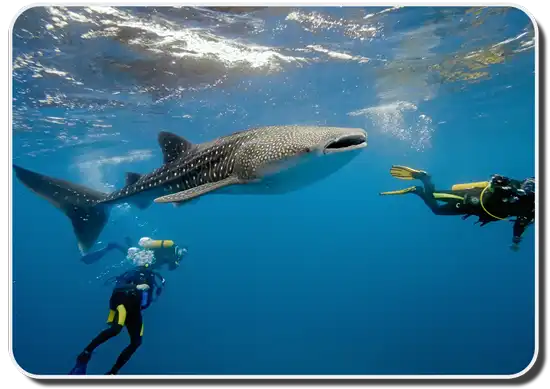
-
- Whale Sharks are named for their large size, comparable only to Whales.
-
- They are the only member of the rhincodontidae family of sharks.
-
- Whales Shark are only one of three shark species that feed on plankton. The other two are the basking shark and the megamouth shark.
-
- As a species Whale Sharks are 60 million years old. Though individually, their life expectancy is between 70-100 years.
-
- Whales Sharks are highly migratory but move very slowly, cruising at 2.3 miles per hour.
-
- One Whale Shark was tracked as migrating 8000 miles.
-
- Whale Sharks tend to live most of their lives alone. Though they have occasionally been seen in large groups.
-
- Whale Sharks often travel with schools of tuna.
-
- Though they prefer to stay near the surface, Whale Sharks can dive up to 5000 feet below the surface.
-
- Whale Sharks can feed vertically, a behavior known as standing on their tail.
-
- Unlike other sharks that use their tails to swim, Whale Sharks swim by moving their bodies side to side.
-
- Whale Sharks prefer to live in warm, tropical environments. They thrive in water that is around 70 degrees fahrenheit.
-
- Whale Sharks tend to be found in open and coastal waters along the 30 latitudinal line and also have been known to enter the mouths of rivers and shallow lagoons.
-
- Adult Whales Sharks have no natural predators. The only threat to their survival is human activity. Although blue sharks and blue marlins have been known to prey on young Whale Sharks.
-
- They swim close to the surface with their mouths open to filter out plankton.
-
- Whale Sharks have massive mouth that can grow to over 4.9 feet wide.
-
- Their mouths have 300 to 350 rows containing up to 4000 tiny teeth that are not used in eating.
-
- They filter the water by sucking in large amounts through their mouths and expelling the rest out of their gills.
-
- Unlike basking sharks, they also filter plankton through a method called ram feeding. So it can eat plankton even when stationary.
-
- Whale Sharks filter an average of 1500 gallons of water an every hour.
-
- They have sensory cells located along their naval grooves that help them detect when there is prey in the water.
-
- If there is not enough plankton to eat, Whale Sharks will supplement their diet with squid or small fish like sardines, small tuna, and anchovies.
-
- Since they rarely consume fish. Small fish like remoras, pilot fish, and juvenile golden trevallies will hitch a ride on a Whale Shark. You can often see them hanging on to the body of the Whale Shark, riding in the water next to the shark, or even inside of its mouth.
-
- Whale Sharks have five gills on each side of their body.
-
- Like most sharks, Whale Sharks have to keep swimming in order to breath.
-
- Whale Sharks are grey with yellow spots and stripes that are as unique in pattern as fingerprints are to humans. They also have smooth white bellies.
-
- Their particular skin pattern is known as countershading, which acts as a form of camouflage.
-
- Whale Shark skin is nearly six inches thick.
-
- Whale Sharks have two dorsal fins and pectoral fins. They also have fins on their tails in their youth.
-
- Whale Sharks tend to breed in warm waters and with multiple partners.
-
- Female Whale Sharks grow larger than male Whale Sharks.
-
- Males have “claspers” a type of reproductive organ that delivers semen to the female by clasping on to her.
-
- Maturing late, Whale Sharks do not begin mating until they are 30 years old.
-
- Every Spring large numbers of Whale Sharks gather off the central western coast of Australia, along the continental shelf. Researchers believe that this is the location of their mating grounds.
-
- Whales sharks are ovoviviparous, which means they gestate in eggs inside of the womb until they are born.
-
- Female Whale Sharks have unusual breeding habits, instead of birthing a litter at a time, they will birth several pups over a long period of time.
-
- Whale Sharks can be pregnant with hundreds of pups at a time.
-
- The first documented pregnant Whale Shark was found with a little or 300 pups inside of her belly.
-
- Pups are born once they’ve reached maturity, measuring 16 to 24 inches in length.
-
- Only 10% of all Whale Shark pups born make it to maturity.
-
- Whales sharks have never attacked humans. In fact they are so docile they will often swim and play with divers. Swimming with Whale Sharks is a very popular tourist activity.
-
- The biggest threat to Whale Sharks is human activity.
-
- Whale Sharks are often hunted for their fins which is used in traditional chinese medicine and as part of the popular shark fin soup.
-
- Whale Sharks are often threatened by pollution. When filtering they can suck up tiny bits of plastic and trash that lodge in their digestive tract, killing them.
-
- They are not scared of boats, so they can often be injury or killed by swimming too close.
-
- Whale Sharks are a protected species in 13 of the 100 countries they visit every year.
These gentle giants are fascinating creatures. However, even with all these Whale Shark facts, still very little is known about the species. Since they are highly migratory it is hard to consistently track their behaviors. Luckily for us, there are new research efforts everyday so we can learn more about these wonderful creatures.
Sources
- Kara Levevre
- Castro ALF, Stewart BS, Wilson SG, Hueter RE, Meekan MG, Motta PJ, Bowen BW & Karl SA (2007). Population genetic structure of Earth’s largest fish, the Whale Shark (Rhincodon typus). Molecular Ecology 16: 5183-5192.
- Joung S-J, Chen C-T, Clark E, Uchida S & Huang WYP (1996). The Whale Shark, Rhincodon typus, is a livebearer: 300 embryos found in one ‘megamamma’ supreme. Environmental Biology of Fishes 46: 219-223.
- Stevens JD (2007). Whale Shark (Rhincodon typus) biology and ecology: A review of the primary literature. Fisheries Research 84: 4-9.
- World Wildlife Fund
